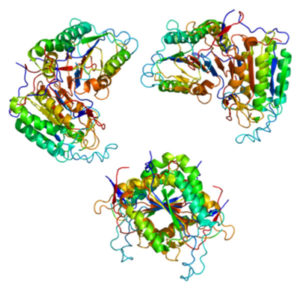Apoptosis is the process of programmed cell death, an intracellular cell death program that rids the body of cells that are no longer needed. It plays an important role in several biological processes to eliminate unwanted cells, such as those that have been damaged beyond repair. It also plays an important role in early development and disease prevention. For example, in development apoptosis is used to remove cells between the fingers of a developing hand. Issues can also arise if apoptosis is prevented as this can lead to uncontrolled cell division and the development of a cancerous tumour. This natural phenomenon causes the death of billions of cells in the human body every day. As such, apoptosis has become one of the most studied topics in cell biology, as understanding the underlying mechanisms behind this process can help us to understand the early development of the human body as well as the pathogenesis of many diseases which can have numerous benefits for the advancement of medicine.
What are Caspases?
Caspases are a highly conserved, large family of aspartate-specific cysteine proteases that are essential for the initiation and execution of apoptosis or programmed cell death. Caspases are present in all cells where they are synthesized as precursors known as pro-caspases. Pro-caspases are converted into mature enzymes by apoptotic signals which can then carry out their activity within the cell. The activation of these proteases has been detected in numerous cell systems.
Caspases are a large family and to date, 12 different mammalian caspases have been identified. These caspases can be divided into three functional groups: initiator caspases (2,8,9, and 10), executioner caspases (3,6, and 7), and inflammatory caspases (1,4,5,11, and 12). As their name suggests, initiator caspases are involved in initiating the apoptosis signal, while executioner caspases are responsible for the mass breakdown of proteins that leads to apoptosis. Inflammatory caspases are not involved directly in apoptosis but function in inflammatory cytokine signalling and other types of cell death such as pyroptosis. For this reason, caspases are an ideal biomarker to detect apoptosis.

Caspase 8 (Image via Wikipedia commons)
How do we detect them?
Caspases can be detected using fluorometric or colorimetric endpoint assays. At Cepham Life Sciences we offer both types of assays which are convenient, one-step procedures that take approximately 1 to 2 hours to do. These assay kits detect the activity of a specific caspase by assaying for the cleavage of a fluorescent or a colorimetric substrate.
The fluorometric assays are based on the detection of cleavage of a substrate. The substrate is composed of a sequence that is recognised by the specific caspase you are targeting, bound to 7-amino-4trifluromethylcoumarin (AFC). The sequence bound to AFC emits blue light (λmax = 400nm) but once AFC is free then it emits a yellow-green fluorescence (λmax =505nm). Quantifying the free amount of AFC using a fluorometer or fluorescence microtiter plate reader can tell you how much caspase is in your sample. Comparing the fluorescence of AFC from an apoptotic sample with the fluorescence produced from an uninduced control sample will allow you to determine the fold increase in caspase activity.
The colorimetric assay works on a similar principle. A substrate is used that is labelled with pNA (N-Acetyl-Trp-Glu-His-Asp-p-nitroanilide). The caspase hydrolyses the substrate, releasing the pNA moiety from the substrate. The pNA has a max absorbance at 405nm and can be used to quantify the specific caspase you are targeting that is present in the sample. This can be achieved by either measuring the absorbance values at 405 nm or from a standard calibration curve prepared using the pNA Dye Standard, using a microplate reader or spectrophotometer. The absorbance of the released pNA from an apoptotic sample can then be compared with an uninduced control sample to determine the fold increase of the caspase in question.
Both assays offer a fast and convenient way of measuring one of the earliest indicators of apoptosis.
How Else Can We Help?
In addition to our caspase assay kits, Cepham Life Sciences offer a range of other products that can help you with apoptosis research including apoptosis inducers and recombinant caspases. For more information have a look at our website or contact one of our team who will be happy to answer all your questions.
Contact Cepham Life Sciences Today!
Cepham Life Sciences team is available to meet all your proteomics and molecular biology laboratory needs. We have a wide range of quality research products, and our team of experts are on hand to offer advice and answer any questions that you have. You can reach us by phone at (410) 636-4954 or Toll-Free at 1-800-257-1565 (USA/CANADA) or by email.
Follow us on Twitter, Facebook, Google+, and LinkedIn to keep up to date on all of our products and promotions.





